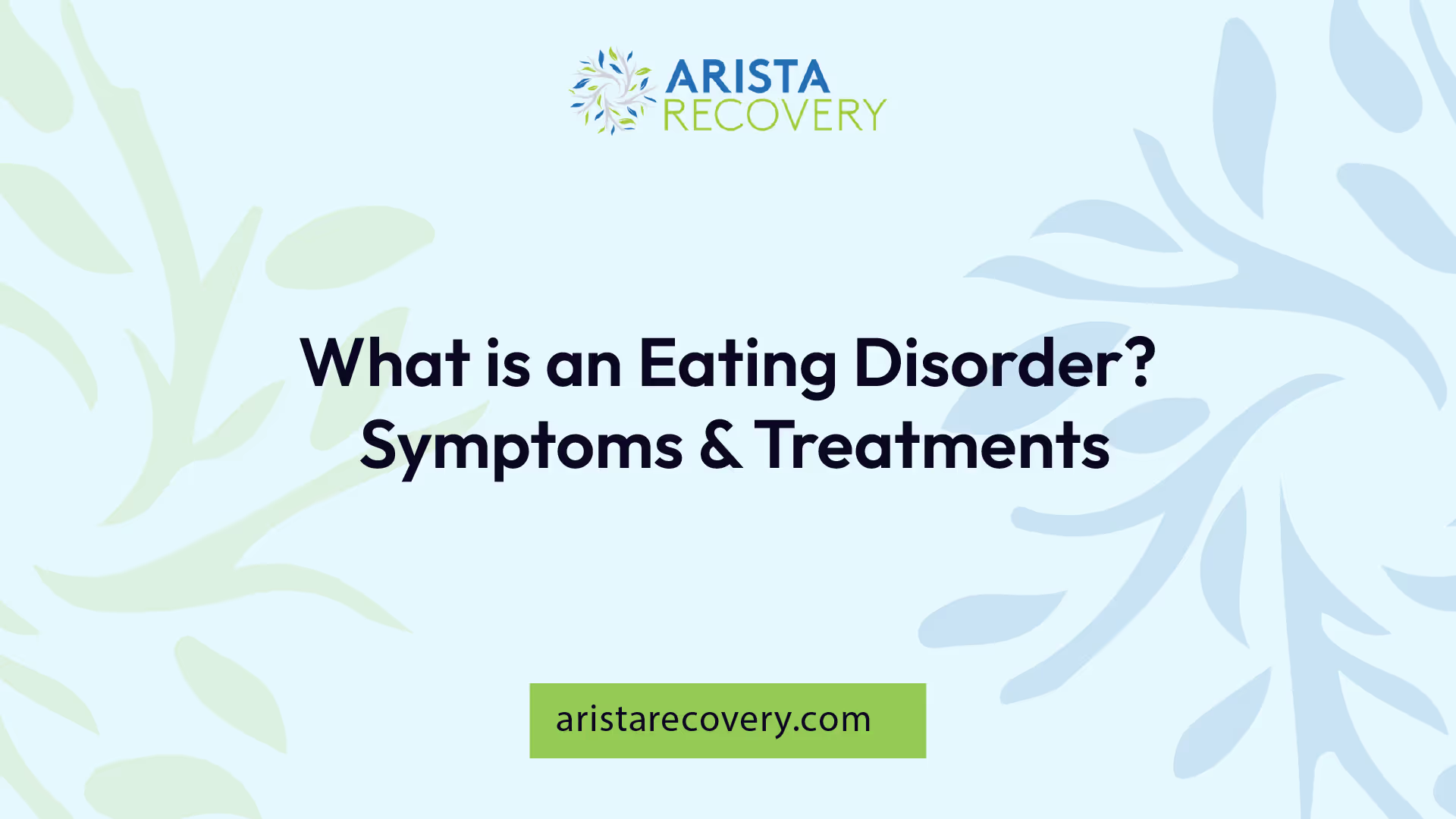What is an Eating Disorder? Symptoms & Treatments

Understanding Eating Disorders
Prevalence of Eating Disorders
Eating disorders can affect individuals from various backgrounds and demographics. The prevalence of these conditions reveals a significant impact on society. In the United States, it is reported that 20 million women and 10 million men will experience an eating disorder at some point in their lives [1]. Notably, females are twice as likely as males to develop such illnesses.

Here's a summary of the prevalence of eating disorders:
DemographicEstimated Affected IndividualsWomen20 millionMen10 million
Eating disorders are not just common; they are also serious. They are recognized as the most deadly mental health disorders globally, resulting in more than 3 million lost healthy years of life [2].
Diagnosis of Eating Disorders
Diagnosing an eating disorder involves a comprehensive approach that focuses on identifying specific symptoms and behaviors. Healthcare and mental health professionals rely on several key factors during the diagnostic process:
Consultation with healthcare professionals is critical for an accurate diagnosis of eating disorders. The classification includes the most common types, such as anorexia nervosa, bulimia nervosa, and binge-eating disorder [3].
For those seeking to understand more about mental health challenges, exploring types of mental disorders can provide additional insights into the spectrum of conditions that may intersect with eating disorders.
Types of Eating Disorders
Eating disorders represent a significant mental health issue that affects individuals across varying demographics. The most common types of eating disorders include anorexia nervosa, bulimia nervosa, and binge eating disorder. Each type has its unique symptoms and characteristics.
Anorexia Nervosa
Anorexia nervosa is primarily characterized by self-starvation, leading to weight loss that results in a body mass index (BMI) typically under 18.5 in adults [4]. The key features of this disorder include:
CharacteristicDescriptionWeight LossUnhealthy low body weight for height and ageFear of Weight GainIntense fear of gaining weightDistorted Body ImageUnrealistic perception of weight and body shapeControl Over EatingExtreme efforts to control weight and body shape
Symptoms of anorexia can severely interfere with health, well-being, and daily life [5].
Bulimia Nervosa
Bulimia nervosa involves alternating between restrictive eating and binge eating. Individuals often consume large amounts of high-calorie foods in short periods, accompanied by a loss of control. This disorder is characterized by the following:
CharacteristicDescriptionBinge EatingConsuming large quantities of foodCompensatory BehaviorsEngaging in fasting, vomiting, or excessive exercisePreoccupation with Food and BodyExcessive thoughts about food, weight, or body shape
Individuals with bulimia nervosa usually experience significant distress regarding their eating habits, which negatively influences their self-worth [4].
Binge Eating Disorder
Binge Eating Disorder is marked by episodes of uncontrolled eating without subsequent compensatory behaviors, such as vomiting or fasting, which distinguishes it from bulimia nervosa. Key features include:
CharacteristicDescriptionEpisodes of Binge EatingFrequent occurrences of binge eatingLoss of ControlA sense of losing control during eatingHealth RisksPotential development of obesity and related conditions
Binge eating disorder can lead to serious health problems, such as obesity, diabetes, and cardiovascular diseases. Diagnosis criteria also include eating more rapidly than normal [4].
Understanding these types of eating disorders is crucial for identifying symptoms and seeking appropriate treatment and support.
Symptoms and Characteristics
Understanding the symptoms and characteristics of different eating disorders is critical in identifying and diagnosing these conditions. Here, the primary symptoms associated with anorexia nervosa, bulimia nervosa, and binge eating disorder are outlined.
Anorexia Symptoms
Anorexia nervosa is characterized by extreme behaviors aimed at weight control that result in unhealthy body weight. Key symptoms include:
SymptomDescriptionUnhealthy Low Body WeightBody weight significantly lower than what is considered healthy; BMI typically under 18.5 in adults. (American Psychiatric Association)Intense Fear of Gaining WeightAn overwhelming fear of becoming overweight, despite being underweight.Distorted View of Weight and ShapeUnrealistic perception of body size and shape, leading to unhealthy behaviors. (Mayo Clinic)Excessive ExerciseEngaging in extreme physical activity to manage weight.
Bulimia Symptoms
Bulimia nervosa involves cycles of binge eating followed by compensatory behaviors. The hallmark symptoms include:
SymptomDescriptionBinge EatingConsuming large amounts of food in a short period of time, accompanied by a sense of loss of control.Purging BehaviorsEngaging in behaviors to prevent weight gain, such as self-induced vomiting or misuse of laxatives. (Mayo Clinic)Preoccupation with Weight and ShapePersistent focus on body weight and shape, often leading to severe self-judgment.Severe Caloric RestrictionLimiting food intake to control weight and manage urges to binge.
Binge Eating Symptoms
Binge eating disorder is characterized by recurrent episodes of eating large quantities of food, and it often leads to physical and psychological issues. Symptoms include:
SymptomDescriptionFrequent Binge Eating EpisodesConsuming large volumes of food within a short time frame, often daily. (American Psychiatric Association)Sense of Loss of ControlFeeling as though one cannot stop eating even when uncomfortably full.Eating RapidlyConsuming food quickly, often without savoring or enjoying it.Absence of Compensatory BehaviorsUnlike bulimia, individuals do not engage in purging or fasting.
Recognizing these symptoms is a critical step in understanding what is an eating disorder and beginning the journey toward treatment and recovery. It's important for individuals experiencing these symptoms or observing them in others to seek help, as early intervention can significantly improve outcomes.
Treatment Approaches
The treatment of eating disorders requires a comprehensive approach that often includes behavioral therapy and medication. Understanding these treatment options is essential for anyone seeking to support someone affected by these conditions.
Behavioral Therapy
Behavioral therapy has been found to be effective in treating eating disorders. Different behavioral therapies are available for this purpose, including cognitive-behavioral therapy (CBT), dialectical behavior therapy (DBT), and interpersonal therapy [3].
Therapy TypeDescriptionEffectivenessCognitive-Behavioral Therapy (CBT)Focuses on changing negative thought patterns and behaviors related to food and body image.Highly effective for many eating disorders.Dialectical Behavior Therapy (DBT)Combines cognitive-behavioral techniques with mindfulness strategies.Useful for addressing emotional regulation and interpersonal issues.Interpersonal Therapy (IPT)Focuses on improving interpersonal relationships and communication skills.Beneficial for those whose eating disorders are related to relationship issues.
Each type of therapy may be tailored to meet the specific needs of the individual, promoting recovery and long-term wellness. It is important for individuals seeking help to consult with a professional to find the right type of therapy.
Medication Options
Medicines can also play a role in the treatment of eating disorders, particularly for those with binge eating behaviors. Antidepressants, especially, are commonly used in combination with talk therapy for conditions like bulimia and binge-eating disorder. However, it is important to note that antidepressants are not effective for individuals who are underweight [6].
Medication TypeUseEffectivenessAntidepressantsPrimarily prescribed for bulimia and binge-eating disorder.Can help reduce binge eating episodes and improve mood.Anti-anxiety medicationsSometimes used to alleviate anxiety that can accompany eating disorders.May be effective depending on the individual's specific needs.
It is essential to work with a healthcare professional to determine the appropriate medication and dosage, as medication alone is often not sufficient. Combining medication with therapy can enhance recovery outcomes for individuals facing eating disorders.
Seeking Help and Support
National Eating Disorders Association (NEDA)
The National Eating Disorders Association (NEDA) serves as a valuable resource for individuals seeking help for eating disorders. NEDA offers a variety of tools and information to support those affected by these conditions. They provide a confidential screening tool that allows individuals to learn more about eating disorders and assess their symptoms.
In addition to screening, NEDA assists individuals in locating treatment providers for eating disorders in their area or available online. This accessibility is vital for those in need of immediate support as it connects individuals with professionals who can guide their recovery journey. For comprehensive support options, individuals can visit NEDA's get help page.
Free and Low-Cost Support Options
Financial barriers often prevent individuals from seeking necessary treatment for eating disorders. Recognizing this challenge, NEDA also offers free and low-cost support options tailored to help those in need.
These resources facilitate connection with others who understand the struggles associated with eating disorders, creating a community of support. Additionally, F.E.A.S.T. (Families Empowered and Supporting Treatment) provides education and resources specifically for parents and caregivers of those impacted by eating disorders [7].
Individuals can access various support groups, helplines, and community programs that provide encouragement and coping strategies in a safe, understanding environment. Understanding these resources is crucial for anyone asking themselves what is an eating disorder, as it can guide them towards reclaiming their health and well-being.
Impact on Health
Eating disorders can have severe consequences on both physical and emotional health. Understanding these effects is crucial for recognizing the seriousness of these conditions.
Physical Consequences
The physical impacts of eating disorders can be life-threatening. Various health issues arise from malnutrition, improper body weight, and erratic eating behaviors. Some common physical health consequences include:
Health IssueDescriptionElectrolyte DisturbancesConditions like hyponatremia (low sodium) and hypokalemia (low potassium) are frequently seen in individuals suffering from eating disorders. These imbalances can lead to dangerous complications, including cardiac arrest.Cardiovascular ComplicationsIndividuals may experience bradycardia (slow heart rate), where the heart slows down to conserve energy due to inadequate food intake. This can lead to a resting heart rate below 60 beats per minute, significantly increasing the risk of heart-related problems.Digestive IssuesChronic restriction or binging can lead to gastrointestinal problems, including delayed gastric emptying and gastroesophageal reflux disease (GERD).OsteoporosisMalnutrition can lead to decreased bone density, making individuals more susceptible to fractures and breaks.ImmunosuppressionNutritional deficiencies weaken the immune system, increasing the risk of infections and illnesses.
Addressing these physical health issues requires comprehensive treatment that includes the support of medical professionals.
Emotional and Mental Health Effects
The emotional and psychological toll of eating disorders can be profound. They often co-occur with mental health issues such as depression, anxiety, and obsessive-compulsive disorder (OCD). The emotional impacts include:
Mental Health IssueDescriptionDepressionIndividuals may experience feelings of hopelessness and a persistent low mood due to the effects of starvation and social isolation.AnxietyMany individuals with eating disorders develop intense fears surrounding food, body image, and weight gain, leading to generalized anxiety disorders or panic attacks.Low Self-EsteemNegative body image and feelings of worthlessness are common in those struggling with these disorders.Social WithdrawalEating disorders can lead to isolation from friends and family due to the shame or secrecy surrounding eating habits.
Treatment approaches often involve a combination of medical care, nutritional guidance, and psychological support. For further information on the treatment options available, explore the section on types of psychotherapy.
Recognizing the extensive impact of eating disorders on overall health is essential for seeking appropriate help. Resources such as the National Eating Disorders Association (NEDA) can provide assistance in finding support and treatment in one's area.
References
[2]:
[3]:
[4]:
[5]:
[6]:
[7]:
You’re not alone in this.
When mental health challenges and addiction intersect, it can feel isolating. At Arista, we offer compassionate, evidence-based, and trauma-informed care to help you heal, grow, and move forward.
You’re not alone in this.
When mental health challenges and addiction intersect, it can feel isolating. At Arista, we offer compassionate, evidence-based, and trauma-informed care to help you heal, grow, and move forward.
Support that moves with you.
You’ve taken a brave first step. At Arista Recovery, we’re here to help you continue with best-in-class care designed for long-term healing and support.
.webp)






